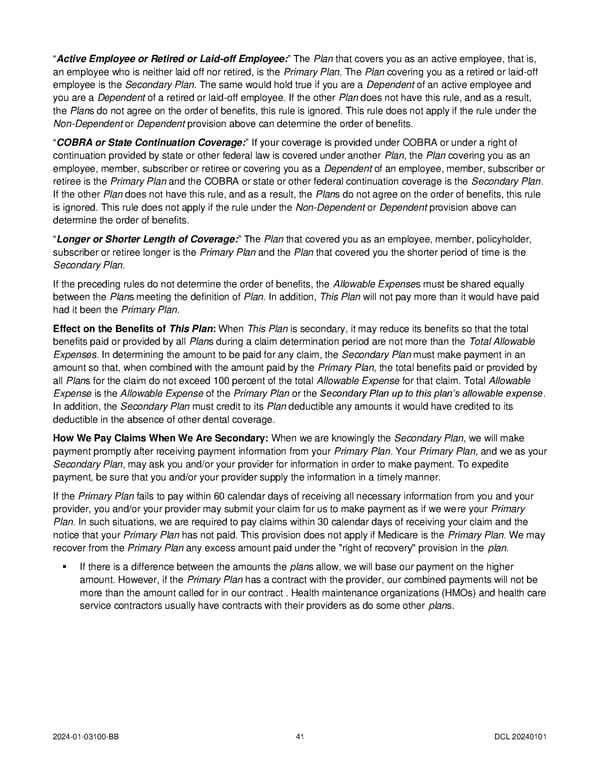“Active Employee or Retired or Laid-off Employee:” The Plan that covers you as an active employee, that is, an employee who is neither laid off nor retired, is the Primary Plan. The Plan covering you as a retired or laid-off employee is the Secondary Plan. The same would hold true if you are a Dependent of an active employee and you are a Dependent of a retired or laid-off employee. If the other Plan does not have this rule, and as a result, the Plans do not agree on the order of benefits, this rule is ignored. This rule does not apply if the rule under the Non-Dependent or Dependent provision above can determine the order of benefits. “COBRA or State Continuation Coverage:” If your coverage is provided under COBRA or under a right of continuation provided by state or other federal law is covered under another Plan, the Plan covering you as an employee, member, subscriber or retiree or covering you as a Dependent of an employee, member, subscriber or retiree is the Primary Plan and the COBRA or state or other federal continuation coverage is the Secondary Plan. If the other Plan does not have this rule, and as a result, the Plans do not agree on the order of benefits, this rule is ignored. This rule does not apply if the rule under the Non-Dependent or Dependent provision above can determine the order of benefits. “Longer or Shorter Length of Coverage:” The Plan that covered you as an employee, member, policyholder, subscriber or retiree longer is the Primary Plan and the Plan that covered you the shorter period of time is the Secondary Plan. If the preceding rules do not determine the order of benefits, the Allowable Expenses must be shared equally between the Plans meeting the definition of Plan. In addition, This Plan will not pay more than it would have paid had it been the Primary Plan. Effect on the Benefits of This Plan: When This Plan is secondary, it may reduce its benefits so that the total benefits paid or provided by all Plans during a claim determination period are not more than the Total Allowable Expenses. In determining the amount to be paid for any claim, the Secondary Plan must make payment in an amount so that, when combined with the amount paid by the Primary Plan, the total benefits paid or provided by all Plans for the claim do not exceed 100 percent of the total Allowable Expense for that claim. Total Allowable Expense is the Allowable Expense of the Primary Plan or the Secondary Plan up to this plan’s allowable expense. In addition, the Secondary Plan must credit to its Plan deductible any amounts it would have credited to its deductible in the absence of other dental coverage. How We Pay Claims When We Are Secondary: When we are knowingly the Secondary Plan, we will make payment promptly after receiving payment information from your Primary Plan. Your Primary Plan, and we as your Secondary Plan, may ask you and/or your provider for information in order to make payment. To expedite payment, be sure that you and/or your provider supply the information in a timely manner. If the Primary Plan fails to pay within 60 calendar days of receiving all necessary information from you and your provider, you and/or your provider may submit your claim for us to make payment as if we were your Primary Plan. In such situations, we are required to pay claims within 30 calendar days of receiving your claim and the notice that your Primary Plan has not paid. This provision does not apply if Medicare is the Primary Plan. We may recover from the Primary Plan any excess amount paid under the "right of recovery" provision in the plan. ▪ If there is a difference between the amounts the plans allow, we will base our payment on the higher amount. However, if the Primary Plan has a contract with the provider, our combined payments will not be more than the amount called for in our contract . Health maintenance organizations (HMOs) and health care service contractors usually have contracts with their providers as do some other plans. 2024-01-03100-BB 41 DCL 20240101
 DeltaCare COC (2024) Page 44 Page 46
DeltaCare COC (2024) Page 44 Page 46